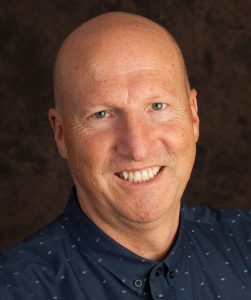
by Kim McCloskey | Aug 9, 2018 | About Storytelling
 Paul Stout is a Utah businessman who appreciates the value of a good story. He has been attending the Timpanogos Storytelling Festival with his family since its inception at the Ashton’s home in Orem over 20 years ago. They were initially invited by his mother-in-law, Sharon Kresge, who was a librarian at the Orem City Library (now retired). After the first story, they were hooked.
Paul Stout is a Utah businessman who appreciates the value of a good story. He has been attending the Timpanogos Storytelling Festival with his family since its inception at the Ashton’s home in Orem over 20 years ago. They were initially invited by his mother-in-law, Sharon Kresge, who was a librarian at the Orem City Library (now retired). After the first story, they were hooked.
Paul says, “This has become a family tradition. We always get a family pass (plus sometimes a few individual passes) so all our children can attend. We look forward to it as the final big event of the summer. More than anything, it’s the stories and amazing storytellers that bring us back. Even if we’ve heard the same story many times, we still love hearing it again. For example, we’ve probably heard Donald Davis tell “Peas and Carrots” at least a dozen times live and another dozen times on CD in the car, and we never grow tired of it. It’s a classic, along with almost all Donald Davis stories, along with those from Bill Lepp, Carmen Deedy, Kevin Kling and many others.”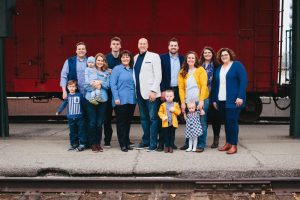
We recently asked Paul if he thought his experience with the festival, or with other storytelling events, has helped him in his profession, other than being a respite from a busy workweek? If so, how?
“Absolutely! In my profession as a sales VP for large technology company, I often give presentations to audiences from 10 to 1,000 people. And over the years I’ve adapted my style, based on what I’ve learned from the Timpanogos master storytellers.
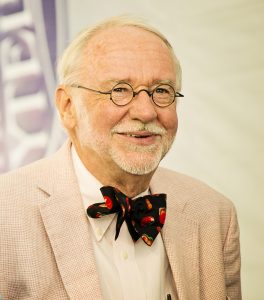
I learned from Donald Davis that people don’t want long, flowery sentences about esoteric subjects. People like to hear down-home, easy-to-understand stories about real-life people having real-life experiences. Donald Davis jumps right into a story without any mood setting or lengthy descriptions.
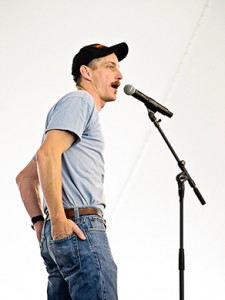
I learned from Bill Lepp that a “little” exaggeration makes for a better story.
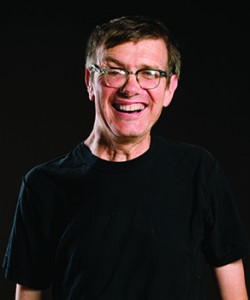
I learned from Kevin Kling that when I share my background (good and bad) with my audience, they tend to appreciate my message even more.

I learned from Carmen Deedy that talking about my relatives is a great way to build a relationship with my audience … because WE ALL have one of THOSE relatives! ”
Have your learned something from a master storyteller? How has the Timpanogos Storytelling Festival enhanced your life? Let us know in the comments below. Tickets for this year’s storytelling festival are available now. I hope to see you there!
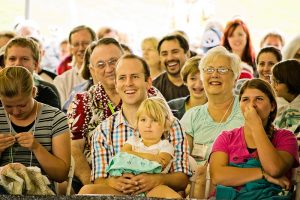
by Kim McCloskey | Jul 24, 2018 | About Storytelling
You already love storytelling.
No really, you do! Think about it. What is your favorite movie, and why do you like it so much? I’ll tell you mine while you think about that.
I love Star Wars. And when I say “love,” I mean with all my Jedi heart. The space combat always made me want to grow up to be a fighter pilot (although that didn’t happen), and the lightsaber fights produced a good amount of imagination involving wooden dowels and red and green spray paint—not to mention a few good bruises. The planets and worlds were spectacular, the aliens were new and exciting, and the Force was as mystical as it remains to this day. But toss out the starfighters, the laser swords, and worldbuilding, and what are we left with?
Story.
It’s the story of a young farm boy who sets off on adventure and ends up saving the galaxy (spoilers). It’s about the vast cast of characters with their individual story arcs, their tests and trials, and their successes and failures. That is what Star Wars is all about.
So what’s your favorite movie? What’s the story there?
I bet your favorite movie has memorable characters, emotional scenes, or even some good bits of humor thrown in to lighten the mood. These are all aspects of story. And it’s not just movies, either. Books, comics, music, ancient cave paintings, dinnertime conversation, explaining to your boss why you’re late for work…practically everything we do is linked to storytelling, and your brain is already hardwired to love it.
That’s right; you’re one of us.
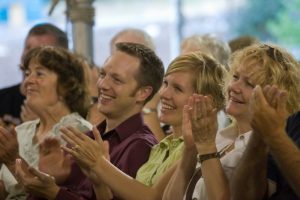

The tellers at the Timpanogos Storytelling Festival bring their stories to life, but it’s more than just sitting back and listening to tall tales. Personal stories bring our hearts closer together, bridging gaps we didn’t know existed (or have been trying to traverse for years). These tellers tell stories of their childhood—about their parents and grandparents, yes—but their stories have meaning. Real meaning that you, fair reader, can take with you to help you through whatever difficulty you’re facing.
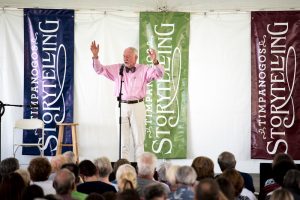 Because we’ve all been there. No matter who you are, someone has been in a similar situation as you, and when we listen to the stories that we can relate with, we don’t feel so alone anymore. We connect with the teller, and the teller connects with us.
Because we’ve all been there. No matter who you are, someone has been in a similar situation as you, and when we listen to the stories that we can relate with, we don’t feel so alone anymore. We connect with the teller, and the teller connects with us.
And it’s more than just getting through a difficult time. Laughter is good for anybody in any stage of life. These storytellers weave humor into their stories so well that it’s practically magic how quickly the audience can go from tears to laughter. Some stories are all about the humor. But unlike that mediocre comedy that Netflix insists you watch, these stories are filled with meaning, depth, and a personal touch you simply can’t get anywhere else.
If you’ve never been to the Timpanogos Storytelling Festival before, this is the year to make amends and come. After all, you already love storytelling. Why not indulge a little bit?
You deserve it.
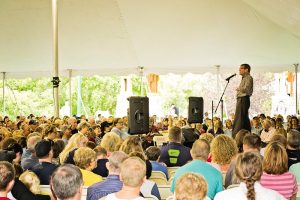
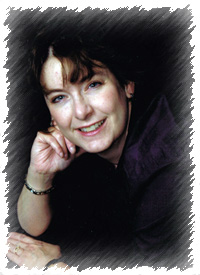
by Kim McCloskey | Jul 21, 2018 | About Storytelling, Benefits of Storytelling, Conferences
I was fortunate to attend a writing conference here in Utah recently, and while I learned heap of valuable information and ways to improve my own writing, I was excited to see a professional storyteller had been invited to teach a number of classes. Of course, I made it a point to attend them.
The name of the storyteller in question is Julie Barnson, a local of these parts. The first class of hers I attended was all about the process of telling a great story. And it was wonderful. One of the main things she discussed in this class was how to go about learning a story. For me, this was valuable for both telling my own stories as well as incorporating these tactics into my writing to be able to craft more vivid images for my readers.
According to Julie, telling a story is taking a picture in your head and painting it in the listener’s ear. Image by image, scene by scene. If you know the story you want to tell, you more than likely have images in your head associated with that story. Describe them! Make it real.
She also warned against memorizing the entire thing (which I am guilty of doing). Instead, memorizing the first line as well as the last line will help you get going (have you ever stood in front of a crowd and had your mind go blank? Me too. Hence memorizing the beginning to help get your brain in gear) and help your ending retain the power you want it to have. Of course, a few other things such as in-story poems, chants, rhymes, and the like should also be memorized. And that’s it!
Thankfully I don’t have to memorize beginnings and endings when I’m writing (as I can simply scroll back to the top to see what the beginning is), but this is a great tip for oral storytelling.
The second class of Julie’s I attended was her telling Greek myths—ones everyone ought to know but probably don’t. She told the story of Perseus, the story of Orpheus and Eurydice, and the story of the Trojan War. Now, I’ve read these stories before, and had learned them in school, but never had I heard them in such a riveting way as she told them.
And there is power in knowing these old myths. After all, a lot of our lingo stems from them. For example, when we talk about someone’s Achilles’ heel, we’re referencing a Greek myth. Knowledge is power—especially for storytellers—and as they always said during Saturday morning cartoons in the ’80s, “Knowing is half the battle!”
I encourage you, fair reader, to learn the myths of old, if not to tell then to gain a greater appreciation of the world around you (but let’s be honest, you’ll most likely end up telling these stories to your kids and grandkids as well). I also encourage you to find a story you love and practice telling it. Find the images that encapsulate the story, that invoke powerful emotions, and practice telling that story to your reflection in the mirror, your spouse, your kids or grandkids, and anyone else that will listen.
When doing so, keep this in mind: how do you speak when you’re excited about something? Do you move your hands in grandiose gestures? Do you contort your face when telling scary tales? And what about body language? Hands on hips for petulance, chin up for pride, and other ways help portray the message along with your words. Experiment with facial expressions, hand gestures, and body language to help your story come alive.
So go on. Indulge in the gift that is storytelling.
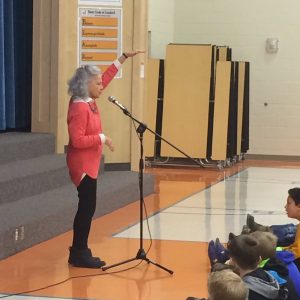
by Kim McCloskey | Jul 19, 2018 | About Storytelling
When did you first catch the storytelling bug? Can you remember the first time you were charmed as a professional teller spun a captivating tale? For more than 154,000 Utah students, their first taste of the storyteller’s art has happened in their very own school.
 Since 2014, Timpanogos Storytelling Institute has offered an education program unlike any other in the world. The Utah State Legislature generously sponsors the Professional Outreach Program in the School (POPS) that brings free or subsidized art education to Utah public and charter schools. In addition to Timpanogos Storytelling, the POPS program includes professional arts companies such as Utah Symphony, Ballet West, Utah Shakespeare Festival, and the Springville Museum of Art. As a member company, Timpanogos Storytelling Institute developed a program of storytelling performances, workshops and resources that we’ve presented to schools in every corner of the state.
Since 2014, Timpanogos Storytelling Institute has offered an education program unlike any other in the world. The Utah State Legislature generously sponsors the Professional Outreach Program in the School (POPS) that brings free or subsidized art education to Utah public and charter schools. In addition to Timpanogos Storytelling, the POPS program includes professional arts companies such as Utah Symphony, Ballet West, Utah Shakespeare Festival, and the Springville Museum of Art. As a member company, Timpanogos Storytelling Institute developed a program of storytelling performances, workshops and resources that we’ve presented to schools in every corner of the state.
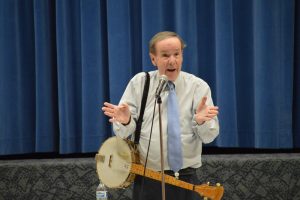
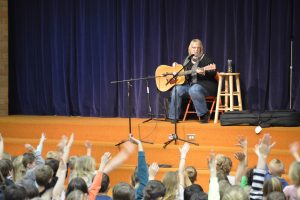
School programs have been an integral part of our Festival almost from the very start. That tradition continues today. Last September, over 7000 students and teachers enjoyed performances at Thanksgiving Point by Donald Davis, Ed Stivender, Shonaleigh, Carmen Deedy and more. This year, students will enjoy the likes of Kim Weitkamp, Daniel Morden, Claire Murphy, and Bill Harley. We’re filling up fast, but we’ve got room to grow at the Festival’s new venue boththis year and in the years to come as we continue the tradition of school visits.
The fun doesn’t stop when the Festival ends, though. We’re just getting started as we take storytelling to the far corners of Utah from September to April. Here’s how it works: we bring some of the best storytellers to Utah during the school year. These include festival favorites such as Donald Davis, Kim Weitkamp, and Bil Lepp. They spend a week traveling around Utah, giving storytelling performances and joining with TSI staff for storytelling workshops in public and charter schools. Educators are given access to resources including recordings of storytelling performances, educational DVDs, and lesson plans designed to help students develop their own stories.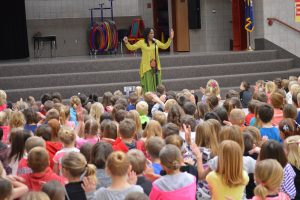
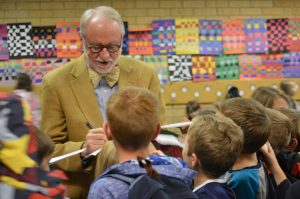
The feedback we receive from these programs is overwhelmingly positive. Not only are we building the next generation of Festival audiences here in Utah, we are also building a generation of Utah kids who can use the magic of storytelling to benefit their own lives. Whether in their work, their relationships, or perhaps as future professional tellers, these students are equipped to captivate their own audiences through the power of a story.
If you would like more information on how to get your school registered for Storytelling in the Classroom, you can find more information on our website https://timpfest.org/stories/storytelling-in-the-classroom/, or contact Marilee Clark at mclark@timpfest.org.

by Kim McCloskey | May 16, 2018 | About Storytelling, How To
 In The Healing Power of Stories Daniel Taylor contends that the stories we tell can reshape our characters and add meaning to our lives by reminding us that actions have consequences. Not all stories are created equal and the better stories, he says, “should be truthful, freeing, gracious, and hopeful.” Stories have the power to heal, reenergize, or even harm our psyche depending on their type, of which there are four; whole, bent, broken and healing.
In The Healing Power of Stories Daniel Taylor contends that the stories we tell can reshape our characters and add meaning to our lives by reminding us that actions have consequences. Not all stories are created equal and the better stories, he says, “should be truthful, freeing, gracious, and hopeful.” Stories have the power to heal, reenergize, or even harm our psyche depending on their type, of which there are four; whole, bent, broken and healing.
Whole stories portray good as good, evil as evil, and good wins. Most of the classics are in this category and most storytellers spend their time with these types of stories.
Bent stories portray evil as good, good as evil, and evil wins. Examples include many horror stories, pornography, and even Hitler’s Mein Kampf. Bent stories can trap us and make us feel hopeless about the world in general.
Broken stories portray good as good, and evil as evil, but evil wins. Something is broken, not right, and needs to be fixed. Examples include Lord of the Flies and 1984. These stories, while not uplifting, have the potential to motivate us to heal something broken in the real world.
Healing stories portray good as good, bad as bad and can be either whole or broken stories. In a healing story the listener is profoundly moved, changed, or healed by the experience of hearing or reading the story. The answer to the problem is offered within the story itself, often in the ending.
In the stories that we tell and the stories we seek out we can look for truth as well as hope. This doesn’t mean that we avoid sad or tragic tales because they are seemingly hopeless. Sad, complicated stories can also elevate the listener if we realize that there are more complex ways to responding to them rather than by just simply being happy or sad. If a story can move us beyond our sadness to find empathy, healing, or a call to action then the well-told tale can continue to live on long after the story is over.


 Paul Stout is a Utah businessman who appreciates the value of a good story. He has been attending the Timpanogos Storytelling Festival with his family since its inception at the Ashton’s home in Orem over 20 years ago. They were initially invited by his mother-in-law, Sharon Kresge, who was a librarian at the Orem City Library (now retired). After the first story, they were hooked.
Paul Stout is a Utah businessman who appreciates the value of a good story. He has been attending the Timpanogos Storytelling Festival with his family since its inception at the Ashton’s home in Orem over 20 years ago. They were initially invited by his mother-in-law, Sharon Kresge, who was a librarian at the Orem City Library (now retired). After the first story, they were hooked.

















